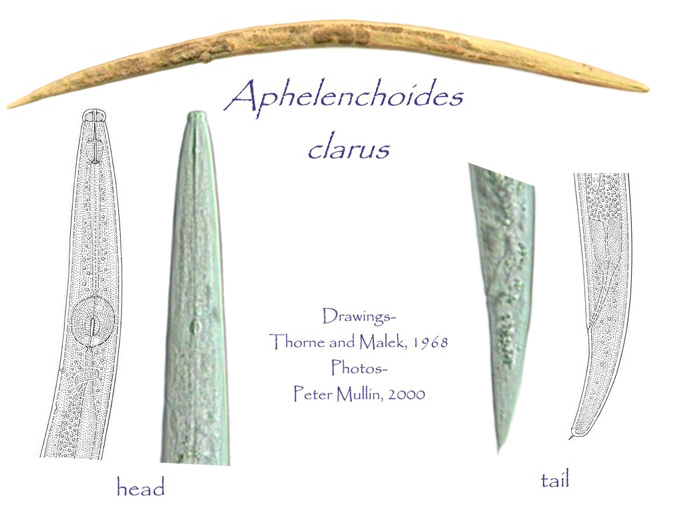Aphelenchoides clarus
Thorne and Malek, 1968

0.3 mm; a = 21; b = 6.2; c = 19; V = 67
Cuticle marked by very fine striae which are interrupted on the lateral
fields by a plain band about 1/5 body width near middle. Lip
region framework lightly sclerotized with refractive cheilorhabdions
about oral opening. Spear 11u long with small but distinct knobs.
Esophageal gland located on left dorsal side, 3 or 4 times as long as body
width. Intestine with broad lumen directed back and forth, dividing it
into relatively huge cells each apparently with only a single nucleus.
Vulva
with slightly elevated lips; vagina extending somewhat forward. Ovaries
with only 5 to 10 oocytes, arranged in single file. An immature egg was
almost 3 times as long as body width. Posterior uterine branch a slender
tube extending 1/2 to 2/3 back to anal region with spermatozoa sparsely
arranged. Prerectal cells without granules, forming a rather clear area
about as long as rectum.
Terminus
broadly rounded with apical mucro. Phasmids almost terminal, located sublaterally.
Males not collected but sperms present in females.
Aphelenchoides clarus is distinctive because of its small size,
narrow band-like lateral fields, peculiar arrangement of spear muscles,
limited number of oocytes in ovary, elongate posterior uterine branch serving
as a spermatheca and transparent prerectal cells.
Habitat: Soil about roots of Scotch Pine, Pinus sylvestris,
near Watertown, South Dakota.
(Description- Thorne and Malek, 1968)
DNA Sequences Obtained
| Specimen: |
Collected: |
| KonzaI CC-13 |
Konza Prairie, First survey |



